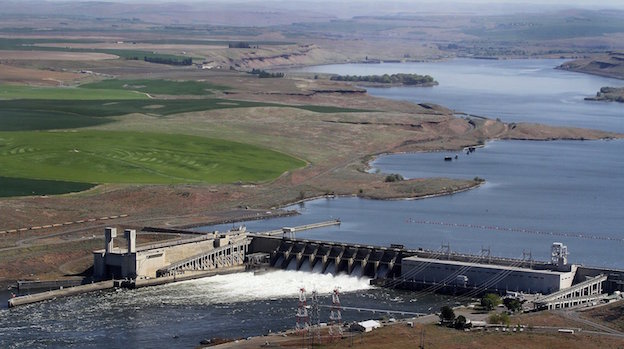forum
library
tutorial
contact

Snake River Dams Must Go
by Mason RogersIdaho Mountain Express, November 27, 2019
|
the film forum library tutorial contact |

|
Snake River Dams Must Goby Mason RogersIdaho Mountain Express, November 27, 2019 |
Let nature do what it does best and take out the cement blocks that are destroying a keystone species.
 I knew I wanted to be an environmentalist from the day I was born. When I was young, my parents took me backpacking and fishing all the time. Seeing the pristine lakes and sleeping under the stars made me realize that Mother Nature can't speak for herself--someone has to do it for her, so I took on the task of completing her wishes.
I knew I wanted to be an environmentalist from the day I was born. When I was young, my parents took me backpacking and fishing all the time. Seeing the pristine lakes and sleeping under the stars made me realize that Mother Nature can't speak for herself--someone has to do it for her, so I took on the task of completing her wishes.
The more I've been exposed to the issue of salmon recovery, the more I am convinced that the removal of the four dams on the lower Snake River is crucial for the survival of migrating salmon, both to and from their spawning grounds. Though dams and hydroelectricity benefit humans by providing jobs, “green” energy, navigation to Lewiston and some irrigation, it's not worth it. Federal agencies are spending millions of dollars trying to recover salmon when Mother Nature can do it so much better if we just let her. Mitigation for juvenile fish losses at dams are not working. The Endangered Species Act, which is supposed to recover threatened species enough to survive on their own, matters. Healthy ecosystems matter. The conclusion: Those four dams are destroying vital river ecosystems and Idaho salmon populations, and they must go.
Dams are just concrete blocks; it's the reservoirs behind them that flood miles of riverine habitat that cause the most problems. A healthy river system should have rapids, continuous change, a diverse plant and animal community and variability in the flow of water. As soon as dams are put in place, and reservoirs build up behind them, the healthy ecosystem dissolves into a slow-moving mass of water that is more like a lake. Behind Lower Granite dam, there are 40 miles of slack water in the reservoir. Without a strong current, Idaho salmon are no longer able to be carried backward along the swift-moving river; they have to turn around and use up energy to swim the entire length of each reservoir.
Every summer, slack water in many reservoirs reaches lethal temperatures. In 2015, 95 percent of spawning sockeye adults died from the disabling hot water before they even reached Idaho. On their downstream migration, many juvenile salmon have trouble finding their way through the murkier waters of the reservoirs--some get lost and die. Others swim to the surface to escape the crowded water as they approach the dams and get eaten up by osprey, or other predators like bears. Disease travels like wildfire from fish to fish. Hunger is felt strongly, because the vegetation, gravel and sediment that create habitat for insects and other prey is thinner, so the food chain is disrupted.
Also, in reservoirs, many banks are fixed in place by riprap and there is less shade for fish to cool off in. Short-lived algae blooms can erupt on the surface, resulting in lower amounts of dissolved oxygen as the algae die and decompose. And finally, reservoirs delay salmon migration patterns and disrupt their biological transformation because navigating through the slow-moving water for 140 miles takes a juvenile salmon two months, when it should only take two weeks.
Dams create problems, too. When Idaho's salmon finally reach each of the four dams on the lower Snake River, they face a whole new set of possibly fatal obstacles. The Army Corps of Engineers has spent more than $600 million on innovative and alternative bypass systems, and they've helped. But still, Idaho salmon are on the threatened and endangered species list and have been for decades. Artificial transport in barges might get juvenile salmon past the dams, but it stresses 50 percent of juvenile sockeye when they are subject to it during their downstream migration, making them more vulnerable to warmer waters when they return as adults. Barged fish can have impaired honing instincts and tend to move upstream slower and with more meandering, which increases their exposure to the warmer, stressful reservoir temperatures. In a NOAA report, biologists reported that sockeye that migrated in rivers as juveniles had five times the survival rates when migrating back as adults to those who were barged downstream. In general, the more human and mechanical handling of juvenile salmon during dam passage, the lower their survival rate is as spawning adults.
If we really want to recover salmon, we have to be sensible, let nature do what it does best and take out the cement blocks that are destroying a keystone species. If salmon go extinct, many other animals and plants could become threatened or endangered as well. Salmon affect our forests, soils, insects, herons, minks, eagles, bears, otters, osprey, wolves, foxes, orcas and even humans. I believe it is necessary that the four lower Snake River dams be removed. If we don't remove them soon, salmon will only be known by their photo in a child's textbook. Is that really what we want? It's not what I want. Nor should you, especially if you care about living in a world with complex, intact and interconnected ecosystems.
learn more on topics covered in the film
see the video
read the script
learn the songs
discussion forum
